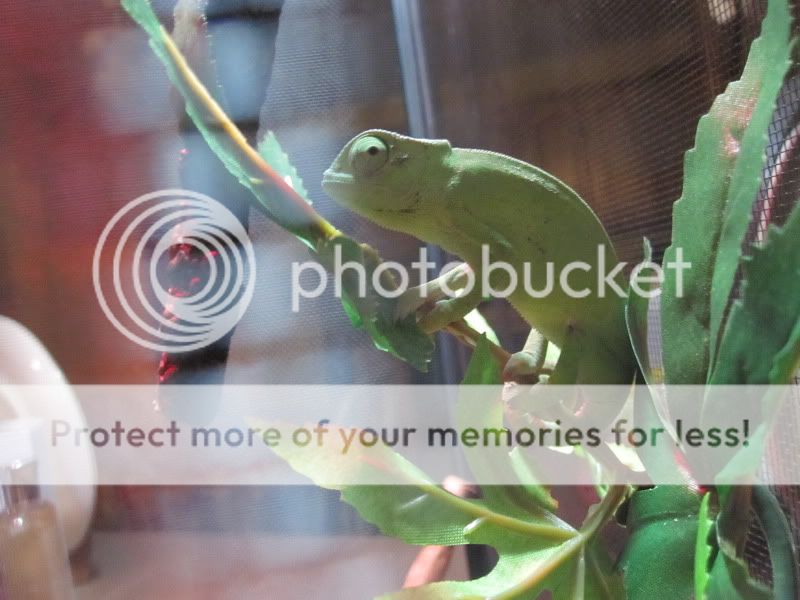Hi, my name's Trav. I've liked chameleons ever since I was a child, and because of this, my girlfriend decided we needed one for my birthday. I have to say, it's both exciting...fascinating, really; and a challenge. I've never been one for the idea of an animal on the same level as a child, but being honest, it suddenly feels something like that!
I've been reading quite a bit, as a I feel a little "behind the eight ball" not having planned for such a thing, but she did quite a bit of research on her own, and we have an open-air screened enclosure, water dripper, thermometer and humidity gauges, dual 75w day basking and 75w red night heat lights, a 5.0 reptimed UVB, and after the first day I picked up a palm, an arboricola and a money tree. He really seems to love the money tree! It's a shame that it sits little higher than the other plants, as once he went up there, he hasn't seemed to have found a reason to come down. I guess he likes moving around in and out of the lights.
I watched him drink the very first day, and saw him eat for sure today. I was just adding three crickets a day, and I think he was eating them, but today I decided to just at one at a time right in front of him, because I was concerned. I seem to think this is a better way to do it.
I also need to get a mister, as the humidity is too low, around 40%. Also, the dripper is dripping on the arboricola, which should be great, but I haven't seen him down there. I put it over the leaves on his tree this morning, and he came over and had a drink, so I don't know if he would go searching for water down to the other plant, or not. A mister would be better for water all over, as well.
The house could use a humidifier anyway, and this might actually prompt me to get one. We could all benefit!
I would like to make sure he is healthy and parasite free. One of my main concerns are these raised imperfections he has on his skin. They are dark blackish in color, and sort of appear like scars, to me. There are a few on his tail, on a knee, one on either side of his head and smaller spots on his face and around his body. I have a pic I took the first night, in which some of them can be seen. Not the best, but it might give an idea:

one of the more prominent spots on his tail can be seen highlighted in the background between his two rear feet. Also, another directly below his back foot. The one on his head behind his eye is easy to see, too, as well as the few various smaller spots on his left side.
Anyway, so that's this story, so far! Thanks for reading
I've been reading quite a bit, as a I feel a little "behind the eight ball" not having planned for such a thing, but she did quite a bit of research on her own, and we have an open-air screened enclosure, water dripper, thermometer and humidity gauges, dual 75w day basking and 75w red night heat lights, a 5.0 reptimed UVB, and after the first day I picked up a palm, an arboricola and a money tree. He really seems to love the money tree! It's a shame that it sits little higher than the other plants, as once he went up there, he hasn't seemed to have found a reason to come down. I guess he likes moving around in and out of the lights.
I watched him drink the very first day, and saw him eat for sure today. I was just adding three crickets a day, and I think he was eating them, but today I decided to just at one at a time right in front of him, because I was concerned. I seem to think this is a better way to do it.
I also need to get a mister, as the humidity is too low, around 40%. Also, the dripper is dripping on the arboricola, which should be great, but I haven't seen him down there. I put it over the leaves on his tree this morning, and he came over and had a drink, so I don't know if he would go searching for water down to the other plant, or not. A mister would be better for water all over, as well.
The house could use a humidifier anyway, and this might actually prompt me to get one. We could all benefit!
I would like to make sure he is healthy and parasite free. One of my main concerns are these raised imperfections he has on his skin. They are dark blackish in color, and sort of appear like scars, to me. There are a few on his tail, on a knee, one on either side of his head and smaller spots on his face and around his body. I have a pic I took the first night, in which some of them can be seen. Not the best, but it might give an idea:

one of the more prominent spots on his tail can be seen highlighted in the background between his two rear feet. Also, another directly below his back foot. The one on his head behind his eye is easy to see, too, as well as the few various smaller spots on his left side.
Anyway, so that's this story, so far! Thanks for reading


